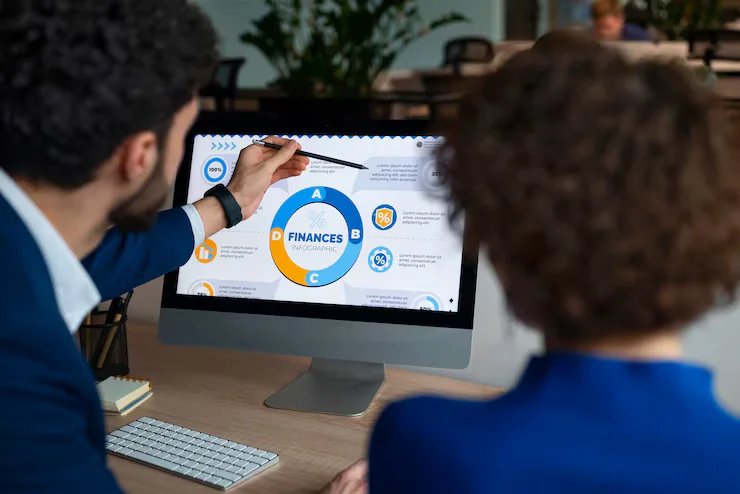Surprisingly, your B2B sales funnel might be leaking more than you think. Did you know that 74.6% of B2B sales take at least four months to close, with nearly half taking seven months or more? This extended timeline isn’t just frustrating, it’s costly.
Furthermore, the modern B2B buying journey has become increasingly complex.
B2B buyers spend a staggering 83% of their time conducting research and discussing decisions internally, leaving just 17% for conversations with your sales team. Our experience with B2B sales funnel optimization shows that identifying and closing these hidden gaps isn’t just about accelerating sales; it’s about survival.
A mere 5% increase in customer retention can more than double your revenue.
However, most companies struggle to identify where their funnel breaks down. With the typical buying journey involving six to ten decision-makers and requiring eight touchpoints just to secure an initial meeting, we often miss critical opportunities to connect and convert.
In this guide, we’ll uncover the five most common gaps in your B2B sales funnel and provide actionable strategies to close them for good.
Where Most B2B Sales Funnel Breaks Down

source: freepik
Despite many companies believing their sales process works well, B2B sales funnels frequently leak at critical points. The traditional funnel model often fails to account for the complex Reality of today’s business buying environment.
Lack of clarity in the buyer journey stages
Today’s B2B buying journey rarely follows a linear path. Buyers move in a zigzag pattern, going up, down, and sideways through your funnel stages. This unpredictable movement creates confusion when companies try to force prospects into rigid funnel structures. Additionally, research shows that B2B buying involves diverse teams working on multiple tasks concurrently, without following a consistent order or journey.
Many companies struggle because they misunderstand this fundamental behavior, stubbornly clinging to outdated models that assume buyers progress neatly from awareness to purchase. Consequently, when your funnel stages don’t match how buyers make decisions, you lose opportunities to engage them at critical moments.
Overlapping roles between sales and marketing
The average overlap between marketing and sales targeting in B2B companies is just 16%. This alarming statistic highlights a fundamental disconnect between teams that are supposedly working toward the same goal. Even more concerning, 65% of sales and marketing professionals believe there’s a lack of alignment between their leaders.
This misalignment creates confusion about who owns which part of the funnel, leading to critical gaps in the customer experience. Meanwhile, sales teams waste valuable time on low-value activities rather than focusing on high-quality prospect engagement. Too many companies allow their sales teams’ time to be consumed by processing orders, sitting in meetings, or chasing unqualified leads.
B2B Sales Funnel: Don’t Ignore Post-Sale Engagement
Perhaps the most overlooked breakdown occurs after the sale. Post-purchase engagement drives 61% of revenue for most companies, yet many organizations continue prioritizing new customer acquisition over retention. When customers aren’t properly nurtured after purchase, they quickly lose interest in your product or service. This oversight is particularly costly, as research indicates that fully engaged clients lead to a 23% premium compared to average clients.
Furthermore, 85% of B2B sales leaders confirm that successful user onboarding creates more loyal customers. Without structured customer success programs, companies miss crucial opportunities to expand relationships, generate referrals, and increase lifetime customer value.
Hidden Gaps in Your B2B Sales Funnel

source: freepik
Examining underperforming B2B sales funnels closely reveals five critical gaps that consistently hinder conversion rates and revenue potential.
1. Undefined Ideal Customer Profile (ICP)
Many organizations create an ICP but struggle to implement it effectively. Instead of guiding strategy, the ICP gets relegated to marketing briefs or new hire orientations.
A poorly defined ICP costs more than missed opportunities; it wastes time, resources, and effort as your team chases the wrong prospects. Without clarity, your sales representatives spread themselves too thin, ultimately leaving money on the table.
2. B2B Sales Funnel: Weak Lead Qualification Criteria
According to industry research, 46% of B2B sales reps list lead quantity and quality as their top challenge, while 67% of lost sales result from improper qualification.
This often happens because sales representatives face time constraints and pressure to meet quotas, especially younger, inexperienced business development representatives (BDRs) who prioritize quantity over quality.
Additionally, inadequate access to prospect data and market insights can hinder accurate qualification and personalized engagement.
3. Poor content alignment across funnel stages
Despite 87% of B2B buyers stating that online content significantly influences their vendor choice, many companies fail to deliver content tailored to different stages of the buying journey. This misalignment creates a disconnect as buyers zigzag through your funnel, especially since B2B content marketing funnels should focus on establishing relationships and fostering leads over time.
4. No clear handoff between marketing and sales
The marketing-to-sales handoff is a critical milestone that can make or break a sale. This handoff becomes particularly challenging when marketing and sales teams have a mere 16% overlap in their target audiences.
Essentially, miscommunication between teams, differing expectations, and a lack of follow-through seriously reduce closing rates and create frustrating experiences for potential customers.
5. Lack of post-sale follow-up and retention strategy
Perhaps the most overlooked gap involves what happens after the sale. Research shows that acquiring a new customer costs five times more than retaining an existing one. A 5% increase in customer retention can boost revenue by 25-95%.
Nevertheless, many B2B companies abandon customers after the purchase, missing opportunities to increase lifetime value and generate valuable referrals.
How to Close These Gaps Effectively

source: freepik
Fixing the gaps in your B2B sales funnel requires systematic strategies backed by data-driven approaches. Let’s explore practical solutions to transform your leaking funnel into a revenue-generating machine.
Refine your ICP using firmographic and behavioural data
High-growth companies make ICP integral to their marketing and sales strategy, leading to efficient demand generation and lead qualification.
To refine your ICP, analyze firmographic data (such as revenue, growth rate, and tech stack) alongside behavioral information (including buying habits and content consumption patterns). Subsequently, put this ICP to work by using it to:
- Define your positioning to frame your solution’s impact on organizational objectives
- Create buyer personas based on professional motivations and challenges
- Prioritize leads using objective measures like ACV and CLTV
- Guide product development decisions
Regularly revisit and refine your Ideal Customer Profile (ICP) as markets evolve and your offerings mature.
Implement lead scoring and qualification frameworks
Lead scoring ranks prospects against a numerical scale based on specific characteristics and actions. A robust framework should include:
Individual data: Job role and seniority to identify decision-makers.
Company data: Firmographic information matching your target business profile. Behavioral data: Website visits, content engagement, and buying intent signals
Implement score degradation, where points expire over time, to maintain accuracy and prevent cheating.
With proper scoring, sales teams can focus on the most promising opportunities and increase conversion rates.
Map B2B Sales Funnel Content to Each Stage
Different funnel stages require tailored content. Develop specific assets for:
- TOFU (awareness): Blog posts, videos, podcasts
- MOFU (consideration): Case studies, webinars, white papers
- BOFU (decision): Customer testimonials, product demos
- Post-purchase: Email follow-ups, personalized reports
Track performance metrics for each stage, measure CTR and bounce rates for awareness content, lead magnet downloads for consideration, and ROI for the decision stage.
Create a seamless sales-marketing handoff process
For seamless handoffs, implement:
- Robust CRM systems to store and organize lead information
- Regular meetings between marketing and sales to discuss lead quality
- Clear documentation of the handoff process with relevant details about each lead
- Feedback loops enabling continuous process improvement
When marketing and sales teams work together, companies achieve 36% higher customer retention rates and 38% higher sales win rates.
Build a structured customer success program
Customer success is not a reactive approach, but rather a structured one that ensures users find continuous value. Build your program by:
- Mapping the customer journey for seamless experiences throughout the lifecycle
- Selecting appropriate digital channels for meaningful interactions
- Using data analytics to track engagement and identify expansion opportunities
- Creating early warning systems for at-risk accounts
This approach helps prevent minor issues from escalating while positioning customer success as a strategic function driving retention and growth.
Optimizing Your Funnel for Long-Term Growth
Creating a robust B2B sales funnel isn’t a one-time effort; it requires ongoing optimization and refinement to maintain peak performance. Once you’ve addressed the major gaps, focus on these strategies to ensure continuous improvement.
Use analytics to track stage-to-stage drop-offs
Funnel drop-offs indicate precisely where prospects are abandoning your pipeline. Identify these critical points by setting up proper tracking for your main conversion paths. First, remember that tools like Google Analytics help calculate the percentage of users who don’t progress to the next funnel stage. Moreover, analyzing these drop-offs provides concrete data on what works and what doesn’t.
For instance, Instacart improved their landing page to purchase conversion rate by 10% in just a few months by identifying its largest funnel drop-offs and running targeted experiments. \
Equally important, analytics help pinpoint friction points that cause users to abandon their purchase, allowing you to refine the overall buying experience.
Run A/B tests on CTAs and landing pages
A/B testing compares two versions of a webpage, email, or offer to determine which performs better. Initially, focus on testing elements with the highest impact on lead generation:
- Call-to-Action (CTA) wording, color, and placement
- Landing page headlines, layout formats, and value propositions
- Images and visual elements that drive engagement
In B2B marketing, be sure to test beyond just top-of-funnel metrics. Measure the impact on lead quality, sales-qualified lead rate, and actual conversion to customers. This provides much more valuable insights than simple click-through rates.
Automate repetitive tasks with CRM tools
Sales teams waste valuable time on manual data entry. Indeed, salespeople spend approximately 17% of their day inputting information into systems. Accordingly, implementing automation tools enables you to streamline workflows and free up time for high-value activities, such as prospecting and closing deals.
CRM systems like Salesflare eliminate manual data entry while providing real-time insights into pipeline health. Additionally, automation can trigger personalized email communication based on specific customer actions, nurture leads with regular content, and facilitate faster handoffs between marketing and sales.
Update B2B Sales Funnel Personas Regularly
Buyer personas aren’t static documents but living resources that require regular refinement. To optimize them effectively, regularly review user interviews and leverage insights from sales and customer service teams. These teams notice patterns that you don’t, and they have the added human connection that reveals crucial customer motivations.
External factors can significantly impact buyer behavior over time. Therefore, sense-check and review your personas annually or after significant market changes to ensure they remain relevant and effective in guiding your funnel optimization efforts.
Conclusion: B2B Sales Funnel
Building an effective B2B sales funnel requires more than just understanding its components. We must actively identify and address these hidden gaps that drain revenue potential. After all, the data speaks for itself, with extended sales cycles and increasingly complex buying journeys, these leaks cost your business significant opportunities daily.
Throughout this guide, we’ve uncovered five critical gaps that plague most B2B sales funnels. Your undefined ICP wastes resources on poor-fit prospects. Weak qualification criteria lead to missed opportunities.
Content misalignment fails to address buyer needs at each stage. Unclear marketing-to-sales handoffs create friction. Perhaps most importantly, neglected post-sale engagement leaves substantial revenue on the table.
The good news? These gaps can be systematically closed. Start by refining your Ideal Customer Profile (ICP) with actual customer data, then implement robust lead scoring frameworks to focus your efforts where they matter most. Additionally, map specific content to each funnel stage, create seamless handoff processes between teams, and build structured customer success programs that drive retention.
Remember that funnel optimization demands ongoing attention. Regular analytics reviews highlight stage-to-stage drop-offs while A/B testing improves conversion points. CRM automation eliminates time-wasting tasks, allowing your team to focus on high-value interactions instead.
Though closing these gaps requires commitment, the rewards significantly outweigh the effort. Companies that master their sales funnel can expect shorter sales cycles, higher conversion rates, and substantially increased customer lifetime value.
Take these insights and examine your funnel critically. Where might it be leaking? Which gap seems most pressing for your organization? Addressing even one of these areas will produce measurable improvements, though a comprehensive approach ultimately delivers the most substantial results.










